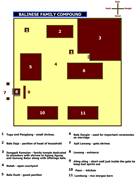The Balinese Family Compound Structure
 Traditional Balinese family compounds have a system of design that is in accordance with adat (traditional law and custom). Visitors to Bali may at first have a hard time noticing this in areas such as Kuta, where Balinese compounds sit adjacent to convenience store and shops. In areas such as Ubud, or in fact any place outside of the tourist scene, the Balinese compounds are easier to spot and figure out. All villages in Bali are laid out according to direction, Balinese direction that is. When asking directions locals will often use the words kaja and kelod. These words are significant to the layout of a family compound. Gunung Agung, the largest peak, is the most sacred place on the island and kaja means ‘facing the mountain’ while kelod means ‘facing the ocean’.
Traditional Balinese family compounds have a system of design that is in accordance with adat (traditional law and custom). Visitors to Bali may at first have a hard time noticing this in areas such as Kuta, where Balinese compounds sit adjacent to convenience store and shops. In areas such as Ubud, or in fact any place outside of the tourist scene, the Balinese compounds are easier to spot and figure out. All villages in Bali are laid out according to direction, Balinese direction that is. When asking directions locals will often use the words kaja and kelod. These words are significant to the layout of a family compound. Gunung Agung, the largest peak, is the most sacred place on the island and kaja means ‘facing the mountain’ while kelod means ‘facing the ocean’.
(click on the diagram for a larger version)
Since Gunung Agung has settlements all around it, kaja and kelod are relative terms. For example in Seminyak kaja is NE and kelod is SW. Up in Lovina, kaja is SE and kelod in north. People don’t get too wrapped up in figuring out the exact compass reference and in the south of Bali ‘kaja’ means roughly north.
Since all village compounds lie on a kaja-kelod line the 2 other directions are called kangin and kauh, meaning ‘where the sun rises‘ and ‘where the sun sets‘. Logically this has a problem too if you consider a place that doesn’t have kaja and kelod exactly on a N-S axis, but never mind, the Balinese stick by this tradition. Being just 8 degrees below the equator, means the sun generally rises exactly to the east and sets exactly to the west.
The Balinese family compound comprises a rectangular perimeter wall and several important structures, each significant and carefully laid out. The Balinese think that the family compound reflects the human body and the first step in building a new compound is consulting a Balinese calendar to choose a suitable day to buy the land and start work. A ceremonial brick is wrapped in a white cloth and holy water is sprinkled on it. These bricks are then buried in each of the buildings to bring good fortune.
The head of the household has to consult a master builder called a ‘undagi‘ who will take a selection of body measurements from the man of the house in the new compound. These measurements are quite complicated and are derived from ancient texts. They include measuring the distance from the tip of the middle finger to the elbow, the width of the palm with the thumb outstretched and the arm-span from fingertip to fingertip. A large man will get permission for a big compound, whereas a man of small stature will build a smaller one.
A unit called the ‘depa asti musti‘ is calculated and that will determine the size of the compound. After building is complete a ceremony called ‘melaspas‘ is performed to bring the building to life.
Carrying on with the body reference the kaja, or top end of the compound is considered most important and represents the head. This is where the ‘bale daja‘ or sleeping quarters for the head of the household is located. The family temple that is the main family shrine dedicated to the souls of ancestors is always located at the kaja-kangin corner facing Gunung Agung and first to see the light of day.
In the center of the compound is an open area which represents the navel and to each side of this are 2 ‘bale‘ structures, which are raised areas with an open air bamboo and alang-alang thatched roof. The ‘bale duah‘ or guest pavilion is located parallel to the kuah wall and the ‘bale dangin‘ or ceremonial pavilion is located parallel to the kangin wall. Both bales represent the arms of the body.
The 2 structures closest to the kelod side of the compound are the ‘paon‘ or kitchen and the ‘lumbung‘ or rice storage barn. These represent the legs and feet. Outside the kelod wall are the garbage dump and the pigpen, these represent the anus.
Traditionally if a man marries before leaving home he is married at his parent’s house and will move in with his wife. This means building often goes on adding new structures, and its is the norm to have 3 generations living together in one compound. If the newly married couple does not have the funds to build a separate house they will continue living with the man’s parents. Traditionally most Balinese people married from the local community. Modern life complicates things, especially if a man from west Bali works in Kuta and marries a girl from East Bali. She is not going to see her family that much.
The Balinese family compound is another wonderful example of how traditional law and culture, seeks to interact with nature in its design.